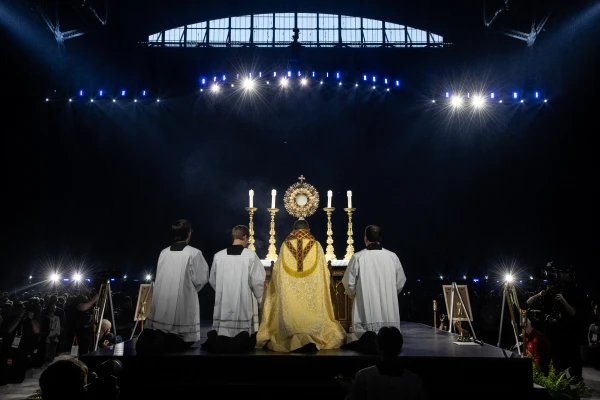Indianapolis, Ind., Jul 20, 2024 / 14:20 pm
Amid divisions in the United States and within the Catholic Church, the National Eucharistic Congress is “a moment of unity” for American Catholics, Bishop Andrew Cozzens told CNA.
In an interview at the congress in Indianapolis on July 19, the bishop of Crookston, Minnesota, who spearheaded the U.S. bishops’ National Eucharistic Revival, observed that a fruit of the congress has been “a real experience of unity.”
“Our society is wrought with division and especially American society with the individualism that breeds division,” Cozzens said.
“Unity in the Church is really essential for us today because that attitude of division in our society affects our Church, and it affects it dramatically,” he added.
More than 50,000 Catholics from all 50 states who speak more than 40 languages are present at the congress, which features keynote speeches and Eucharistic adoration in the Indianapolis Colts’ Lucas Oil Stadium.

“What’s beautiful is we are united here with our bishops. It was the bishops who called us together. We are here because we are Catholic and we share the same faith,” the bishop said.
On Saturday morning, throngs of the faithful packed together in the NFL stadium for a Syro-Malabar liturgy. The Syro-Malabar Church is an Eastern Catholic rite primarily celebrated in India in full communion with the Roman Catholic Church.
Tim del Castillo from California described the experience of attending the Syro-Malabar liturgy as “a very powerful spiritual moment.”
At the end of the nearly two-hour liturgy, the hundreds of concelebrating priests and bishops processed out the corner of the stadium where the football players usually run onto the field at the beginning of the game, he said, and the people spontaneously started clapping and even cheering for the bishops.
“You could feel the support of the laypeople and everybody in the Catholic Church for our bishops who are our leaders — even though we don’t always agree with them necessarily on everything, they are our leaders, they are our fathers,” Castillo said.
“These are the ministers of our sacraments that are going out into the world for us laypeople and giving us the body and blood of Jesus Christ.”
For Castillo, the National Eucharistic Congress has “absolutely” been an experience of Church unity, especially with the opportunities each day for Catholics to pray together at different liturgies, including the Ruthenian-Byzantine rite, the Traditional Latin Mass, and youth Masses with praise and worship.
“You have all these Catholics who are all here to worship the Lord, and it’s okay that we’re doing it in different ways,” he said.
“And the center of it all is the adoration chapel across the street. Jesus in the Eucharist is where all these graces are flowing from,” he added.
Each day of the National Eucharistic Congress, the perpetual Eucharistic adoration chapel has been full of people of all ages kneeling and praying in silence.
(Story continues below)
In the opening ceremony of the congress, Cozzens held up the Blessed Sacrament in a 4-foot monstrance in the center field of the football stadium and led tens of thousands of people in prayer in adoration of the real presence of Jesus in the Eucharist.
Reflecting on the moment, the bishop said: “It was mainly an experience of gratitude to the Lord. I’m just so grateful to the Lord for his faithfulness and his provision and his love for each of us and for love for all these people.”






